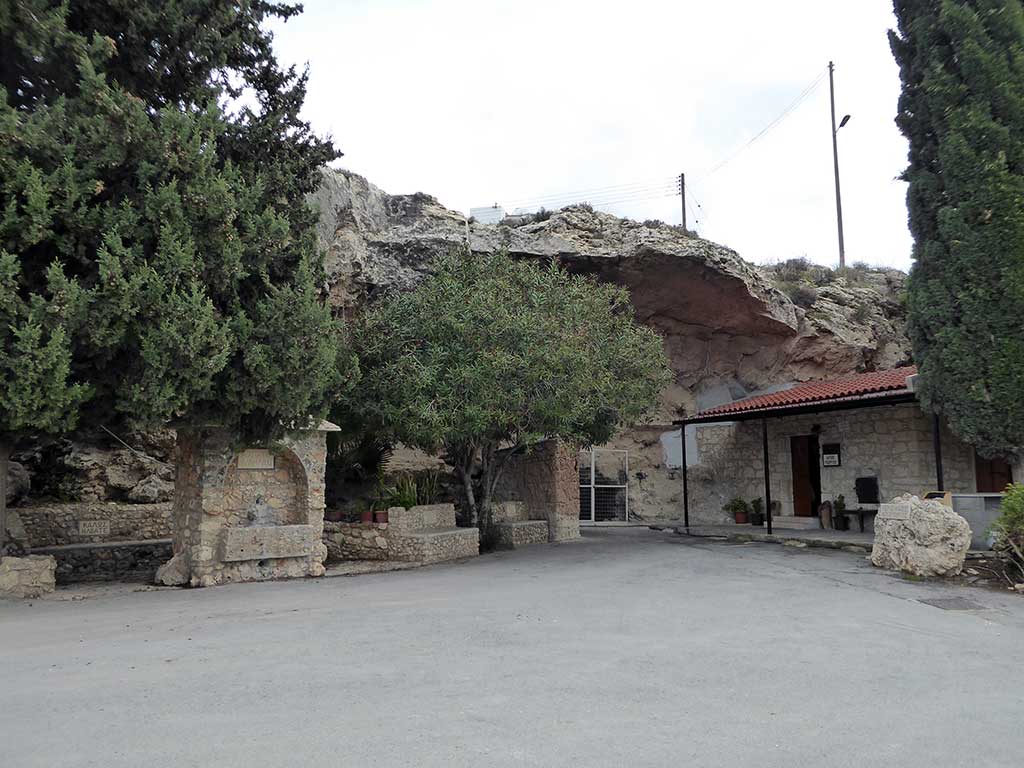Yesterday I , again, walked with the Wednesday group. I drove Jimmy and myself into the outskirts of Paphos where we met at "the second roundabout"
 |
| After a short walk we were at this tiny chapel. I took this image from the Pahos Life website as my photo, as you can see below, was lousy. |
 |
| On the right is the chapel, behind the white fence is a spring that runs all year and just to the left of it is a small shrine. |
 |
| St George's Church |
 |
| Inside the shrine. |
 |
| Inside the church. Cars kept pulling up outside and people would come into the church, pay their respects, light a candle or take a candle out to the shrine. They wouldn't be there for long but I waited a few minutes for the church to empty before taking pictures. |
 |
| According to Wikipedia, St George was Greek and his father died for the Christian faith. He and his mother moved to Syria and then, as a young man, he joined the Roman army. He was sentenced to death for refusing to recant his Christian faith. So where does the dragon fit in? Supposedly while he was living in Libya, as a young man, a dragon was terrorizing the town, demanding first sheep and then human sacrifice. George slew the dragon, saved the young sacrificial girl and gave his reward to the poor. |
 |
| Further along the base of the cliffs there are more caves |
 |
| Some of them have been carved out |
 |
| and a few of them are shrine caves with candles burning and iconography. |
 |
| St George is the most prevalent icon but Christ and the Virgin Mary are also strongly represented. |
 |
| Oddly a couple of the shrine caves had art installations added to the mix. |
 |
| I couldn't find out much about the caves on the internet, or how they came to be shrines. None of the walkers knew either. |
 |
| This little shrine cat was very affectionate and followed us for a way. |
 |
| More art, high up on the cliff. |
We walked through muddy farmer fields and between orange, grapefruit and lemon orchards. On one track through an orchard there was a small tree absolutely covered in small orange fruit. They were about the size of a cherry tomato but a bit more oval than round, not quite the same colour as an orange, smooth skinned. I asked what they were and we stopped. Kumquats was the answer and I was told you eat the whole thing, skin, pits and all. So we did. A crunchy but not unpleasant skin and a tart, citrusy centre. It was very tasty.
 |
| Here we debated the comparative merits of geese vs dogs as burglar deterrents. |
 |
| After the walk, a short drive took as to the restaurant where we had preordered from a menu e-mailed out. I had Moussaka. Most had the pork ribs in Jack Daniel's Sauce. The pork here is supposed to be very good. |
I drove down to Papantoniou's this morning to get the gas canister refilled and do some shopping before the car has to be returned tomorrow. Jimmy had also persuaded me that buying a box of wine was much more economical than bottles and I was going to be here long enough to justify it, so I went to the Cava and bought a 13 litre box for 26 euros (about $3 a litre). I had had the wine at Kay and Jimmy's so knew I liked it.
Today, Nikki had invited me to the monthly lunch of the Air Crews Club. This organization exists in a number of countries and here is made up of previous RAF members though many also flew commercially upon leaving the military. It was held at the Hillview Restaurant which sits right at the top of Pissouri. Nikki and John picked me up and introduced me around when we reached the restaurant. We had drinks and then sat for a presentation by a military historian on the Manhattan Project. I learned more than I needed to know about the science, organization and effects of the bombs dropped on Japan. Then we had a delicious meal. We, again, pre-ordered from an e-mailed menu. I chose Spinach Soup and Chicken Breast in a Honey, Wine and Mustard Sauce. It was yummy and served with roast potatoes, broccoli, carrots and glazed zucchini. I passed on the desserts as I was too full to even finish the chicken (I got a doggy bag). There were lots of interesting people to talk to who had been posted to or had traveled to a variety of places. A surprising number were also sailors and raved about the coast of Turkey for sailing. They said that Croatia has been discovered and is now spoiled, over traveled and expensive while Turkey is still unspoiled and reasonably priced.
 |
| The view from the restaurant. It was a miserable day, weatherwise, pouring rain at times and generally overcast. This view would be much better in the sun. |











































































